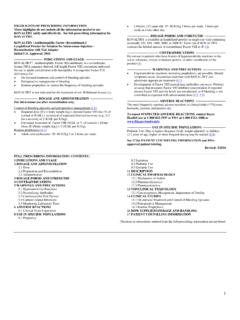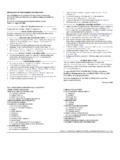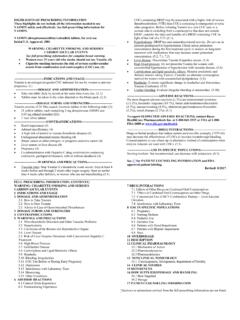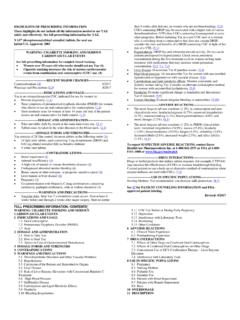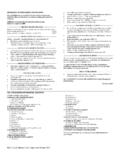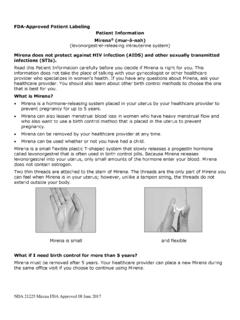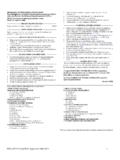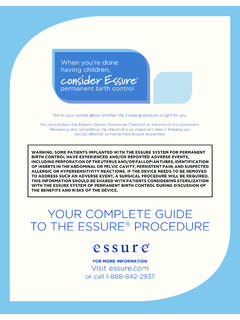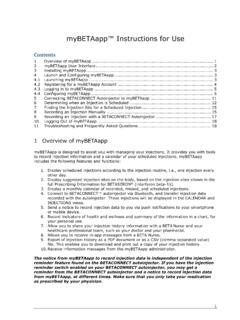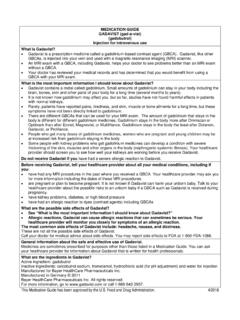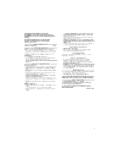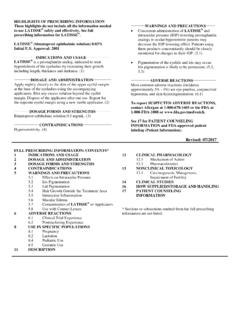Transcription of HIGHLIGHTS OF PRESCRIBING INFORMATION …
1 HIGHLIGHTS OF PRESCRIBING INFORMATION These HIGHLIGHTS do not include all the INFORMATION needed to use NEXAVAR safely and effectively. See full PRESCRIBING INFORMATION for NEXAVAR. NEXAVAR (sorafenib) tablets, oral Initial Approval: 2005 --------------------------- INDICATIONS AND USAGE ---------------------------- NEXAVAR is a kinase inhibitor indicated for the treatment of Unresectable hepatocellular carcinoma ( ) Advanced renal cell carcinoma ( ) Locally recurrent or metastatic, progressive, differentiated thyroid carcinoma refractory to radioactive iodine treatment ( ) ----------------------- DOSAGE AND ADMINISTRATION ----------------------- 400 mg (2 tablets) orally twice daily without food. ( ) Treatment interruption and/or dose reduction may be needed to manage suspected adverse drug reactions. ( ) --------------------- DOSAGE FORMS AND STRENGTHS ---------------------- 200 mg Tablets (3) ------------------------------ CONTRAINDICATIONS ------------------------------ NEXAVAR is contraindicated in patients with known severe hypersensitivity to sorafenib or any other component of NEXAVAR.
2 (4) NEXAVAR in combination with carboplatin and paclitaxel is contraindicated in patients with squamous cell lung cancer. (4) ----------------------- WARNINGS AND PRECAUTIONS ------------------------ Cardiac Ischemia and/or Infarction: Consider temporary or permanent discontinuation of NEXAVAR. ( ) Bleeding: Discontinue NEXAVAR if needed. ( ) Hypertension: Monitor blood pressure weekly during the first 6 weeks and periodically thereafter. ( ) Dermatologic Toxicities: Interrupt and/or decrease dose. Discontinue for severe or persistent reactions, or if Stevens-Johnson syndrome and toxic epidermal necrolysis is suspected. ( ) Gastrointestinal Perforation: Discontinue NEXAVAR. ( ) QT Prolongation: Monitor electrocardiograms and electrolytes in patients at increased risk for ventricular arrhythmias. ( , ) Drug-Induced Hepatitis: Monitor liver function tests regularly; discontinue for unexplained transaminase elevations.
3 ( ) Embryofetal Toxicity: Advise women of potential risk to fetus and to avoid becoming pregnant. ( , ) Impairment of TSH suppression in DTC: Monitor TSH monthly and adjust thyroid replacement therapy in patients with thyroid cancer. ( ) ------------------------------ ADVERSE REACTIONS ------------------------------ The most common adverse reactions ( 20%) for NEXAVAR are diarrhea, fatigue, infection, alopecia, hand-foot skin reaction, rash, weight loss, decreased appetite, nausea, gastrointestinal and abdominal pains, hypertension, and hemorrhage. (6) To report SUSPECTED ADVERSE REACTIONS, contact Bayer HealthCare Pharmaceuticals Inc. at 1-888-842-2937 or FDA at 1-800-FDA-1088 or ------------------------------ DRUG INTERACTIONS---------------------------- --- Avoid strong CYP3A4 inducers. ( ) See 17 for PATIENT COUNSELING INFORMATION and FDA-Approved Patient Labeling. Revised: 12/2017 _____ full PRESCRIBING INFORMATION .
4 CONTENTS* 1 INDICATIONS AND USAGE Hepatocellular Carcinoma Renal Cell Carcinoma Differentiated Thyroid Carcinoma 2 DOSAGE AND ADMINISTRATION Recommended Dose for Hepatocellular Carcinoma, Renal Cell Carcinoma, and Differentiated Thyroid Carcinoma Dose Modifications for Suspected Adverse Drug Reactions 3 DOSAGE FORMS AND STRENGTHS 4 CONTRAINDICATIONS 5 WARNINGS AND PRECAUTIONS Risk of Cardiac Ischemia and/or Infarction Risk of Hemorrhage Risk of Hypertension Risk of Dermatologic Toxicities Risk of Gastrointestinal Perforation Warfarin Wound Healing Complications Increased Mortality Observed with NEXAVAR Administered in Combination with Carboplatin/Paclitaxel and Gemcitabine/Cisplatin in Squamous Cell Lung Cancer Risk of QT Interval Prolongation Drug-Induced Hepatitis Embryofetal Risk Impairment of Thyroid Stimulating Hormone Suppression in Differentiated Thyroid Carcinoma 6 ADVERSE REACTIONS Adverse Reactions in HCC Study Adverse Reactions in RCC Study 1 Adverse Reactions in DTC Study Additional Data from Multiple Clinical Trials Postmarketing Experience 7 DRUG INTERACTIONS
5 Effect of Strong CYP3A4 Inducers on Sorafenib Effect of Strong CYP3A4 Inhibitors on Sorafenib Effect of Sorafenib on Other Drugs Neomycin Drugs that Increase Gastric pH 8 USE IN SPECIFIC POPULATIONS Pregnancy Nursing Mothers Pediatric Use Geriatric Use Patients with Hepatic Impairment Patients with Renal Impairment 10 OVERDOSAGE 11 DESCRIPTION 12 CLINICAL PHARMACOLOGY Mechanism of Action Pharmacodynamics Pharmacokinetics 13 NONCLINICAL TOXICOLOGY Carcinogenesis, Mutagenesis, Impairment of Fertility 14 CLINICAL STUDIES Hepatocellular Carcinoma Renal Cell Carcinoma Differentiated Thyroid Carcinoma 16 HOW SUPPLIED/STORAGE AND HANDLING 17 PATIENT COUNSELING INFORMATION *Sections or subsections omitted from the full PRESCRIBING INFORMATION are not listed. NDA_021923 Nexavar FDA Approved 22 Dec 2017 2 _____ full PRESCRIBING INFORMATION 1 INDICATIONS AND USAGE Hepatocellular Carcinoma NEXAVAR is indicated for the treatment of patients with unresectable hepatocellular carcinoma (HCC).
6 Renal Cell Carcinoma NEXAVAR is indicated for the treatment of patients with advanced renal cell carcinoma (RCC). Differentiated Thyroid Carcinoma NEXAVAR is indicated for the treatment of patients with locally recurrent or metastatic, progressive, differentiated thyroid carcinoma (DTC) that is refractory to radioactive iodine treatment. 2 DOSAGE AND ADMINISTRATION Recommended Dose for Hepatocellular Carcinoma, Renal Cell Carcinoma, and Differentiated Thyroid Carcinoma The recommended daily dose of NEXAVAR is 400 mg (2 x 200 mg tablets) taken twice daily without food (at least 1 hour before or 2 hours after a meal). Treatment should continue until the patient is no longer clinically benefiting from therapy or until unacceptable toxicity occurs. Dose Modifications for Suspected Adverse Drug Reactions Temporary interruption of NEXAVAR is recommended in patients undergoing major surgical procedures [see Warnings and Precautions ( )].
7 Temporary interruption or permanent discontinuation of NEXAVAR may be required for the following: Cardiac ischemia or infarction [see Warnings and Precautions ( )]: Hemorrhage requiring medical intervention [see Warnings and Precautions ( )] Severe or persistent hypertension despite adequate anti-hypertensive therapy [see Warnings and Precautions ( )] Gastrointestinal perforation [see Warnings and Precautions ( )] QTc prolongation [see Warnings and Precautions ( )] Severe drug-induced liver injury [see Warnings and Precautions ( )] Dose modifications for Hepatocellular Carcinoma and Renal Cell Carcinoma When dose reduction is necessary, the NEXAVAR dose may be reduced to 400 mg once daily. If additional dose reduction is required, NEXAVAR may be reduced to a single 400 mg dose every other day [see Warnings and Precautions (5)]. Suggested dose modifications for dermatologic toxicities are outlined in Table 1. NDA_021923 Nexavar FDA Approved 22 Dec 2017 3 Table 1: Suggested Dose Modifications for Dermatologic Toxicities in Patients with Hepatocellular or Renal Cell Carcinoma Dermatologic Toxicity Grade Occurrence Suggested Dose Modification Grade 1: Numbness, dysesthesia, paresthesia, tingling, painless swelling, erythema or discomfort of the hands or feet which does not disrupt the patient s normal activities Any occurrence Continue treatment with NEXAVAR and consider topical therapy for symptomatic relief Grade 2.
8 Painful erythema and swelling of the hands or feet and/or discomfort affecting the patient s normal activities 1st occurrence Continue treatment with NEXAVAR and consider topical therapy for symptomatic relief If no improvement within 7 days, see below No improvement within 7 days or 2nd or 3rd occurrence Interrupt NEXAVAR treatment until toxicity resolves to Grade 0 1 When resuming treatment, decrease NEXAVAR dose by one dose level (400 mg daily or 400 mg every other day) 4th occurrence Discontinue NEXAVAR treatment Grade 3: Moist desquamation, ulceration, blistering or severe pain of the hands or feet, or severe discomfort that causes the patient to be unable to work or perform activities of daily living 1st or 2nd occurrence Interrupt NEXAVAR treatment until toxicity resolves to Grade 0 1 When resuming treatment, decrease NEXAVAR dose by one dose level (400 mg daily or 400 mg every other day) 3rd occurrence Discontinue NEXAVAR treatment Dose modifications for Differentiated Thyroid Carcinoma Table 2.
9 Recommended Doses for Patients with Differentiated Thyroid Carcinoma Requiring Dose Reduction Dose Reduction NEXAVAR Dose First Dose Reduction 600 mg daily dose 400 mg and 200 mg 12 hours apart (2 tablets and 1 tablet 12 hours apart either dose can come first) Second Dose Reduction 400 mg daily dose 200 mg twice daily (1 tablet twice daily) Third Dose Reduction 200 mg daily dose 200 mg once daily (1 tablet once daily) When dose reduction is necessary for dermatologic toxicities, reduce the NEXAVAR dose as indicated in Table 3 below. NDA_021923 Nexavar FDA Approved 22 Dec 2017 4 Table 3: Recommended Dose Modifications for Dermatologic Toxicities for Patients with Differentiated Thyroid Carcinoma Dermatologic Toxicity Grade Occurrence NEXAVAR Dose Modification Grade 1: Numbness, dysesthesia, paresthesia, tingling, painless swelling, erythema or discomfort of the hands or feet which does not disrupt the patient s normal activities Any occurrence Continue treatment with NEXAVAR Grade 2.
10 Painful erythema and swelling of the hands or feet and/or discomfort affecting the patient s normal activities 1st occurrence Decrease NEXAVAR dose to 600 mg daily If no improvement within 7 days, see below No improvement within 7 days at reduced dose or 2nd occurrence Interrupt NEXAVAR until resolved or improved to grade 1 If NEXAVAR is resumed, decrease dose (see Table 2) 3rd occurrence Interrupt NEXAVAR until resolved or improved to grade 1 If NEXAVAR is resumed, decrease dose (see Table 2) 4th occurrence Discontinue NEXAVAR permanently Grade 3: Moist desquamation, ulceration, blistering, or severe pain of the hands or feet, resulting in inability to work or perform activities of daily living 1st occurrence Interrupt NEXAVAR until resolved or improved to grade 1 If NEXAVAR is resumed, decrease dose by one dose level (see Table 2) 2nd occurrence Interrupt NEXAVAR until resolved or improved to grade 1 When NEXAVAR is resumed, decrease dose by 2 dose levels (see Table 2) 3rd occurrence Discontinue NEXAVAR permanently Following improvement of Grade 2 or 3 dermatologic toxicity to Grade 0 1 after at least 28 days of treatment on a reduced dose of NEXAVAR, the dose of NEXAVAR may be increased one dose level from the reduced dose.
